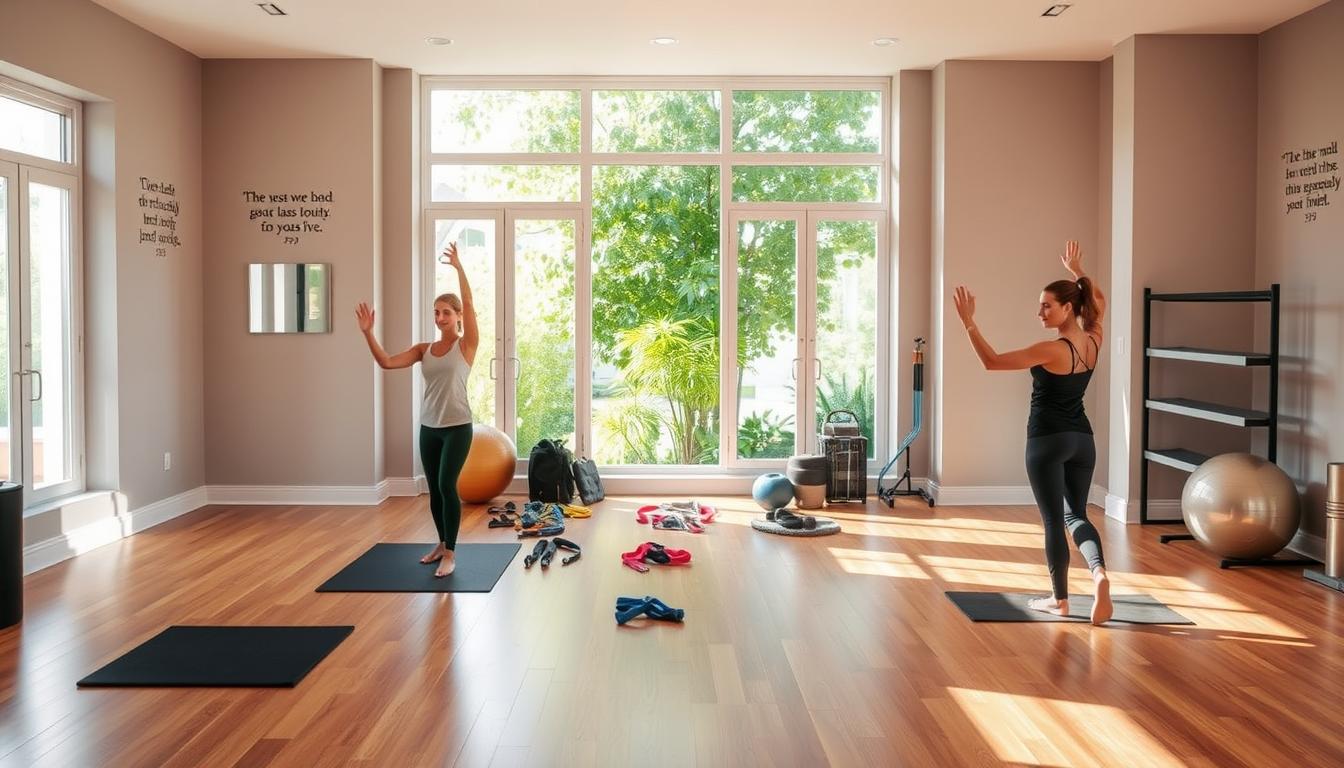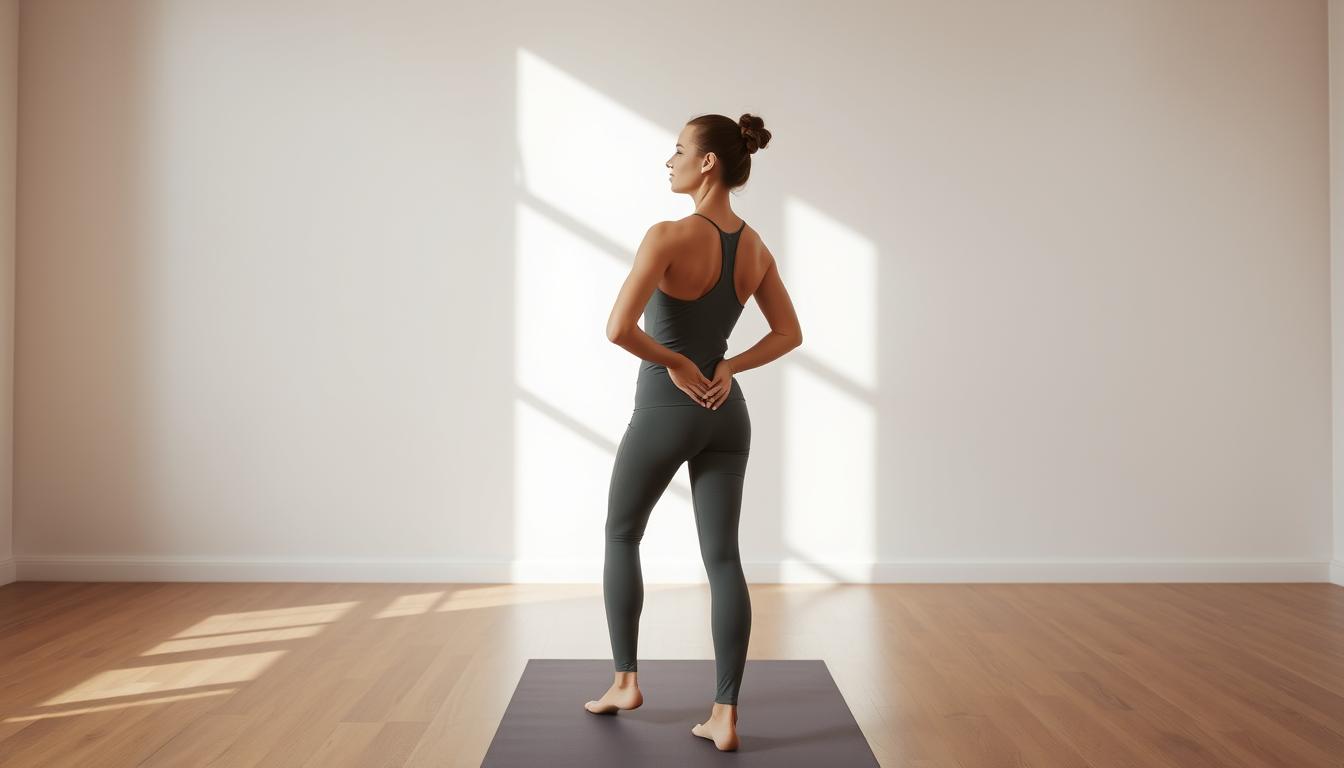I’ve found that adding simple routines to our daily lives can really help with pain and stiffness. If you face challenges with joint issues and staying active, I have good news for you. I’m here to share some of the best routines to try right now.
These gentle exercises can make a big difference in how you feel. It’s important to start slow and then get a bit more challenging. This way, you’ll see better results over time.
Key Takeaways
- Simple exercises can significantly reduce joint discomfort
- Incorporating gentle routines into daily life improves flexibility
- Progressing gradually is key to achieving optimal results
- Maintaining an active lifestyle is important for your overall health
- Effective exercises can be tailored to fit your needs
Understanding Joint Pain and How Exercise Helps
Knowing why joint pain happens is key to feeling better. Exercise is a big part of this. I’ve tried many ways to ease joint pain, and the right workout plan really helps.
Common Causes of Joint Pain
Joint pain can come from arthritis, injury, or too much use. Arthritis is a big reason for joint pain, affecting many people. It makes joints inflamed and worn down, causing pain and stiffness.
Injuries, like from sports or accidents, can also hurt joints. They damage the ligaments, tendons, or cartilage around the joints. Jobs or activities that repeat the same motion can lead to overuse pain.
How Exercise Benefits Painful Joints
Exercise helps in many ways for joint pain. It makes joints move better and stronger. It also cuts down on pain and swelling. Low-impact exercises, like swimming or cycling, are great because they’re easy on the joints.
Working out the muscles around the joint helps too. For example, exercises for the legs can ease knee pain. Keeping a healthy weight is also important to lessen the load on joints like the knees and hips.
Adding exercises for joint pain to your routine can really help. It’s important to pick exercises that fit your condition and fitness level. This way, you can exercise safely and effectively.
Before You Begin: Safety Precautions for Joint Pain Exercises
Before starting exercises for joint pain, it’s important to think about safety. Joint pain can come from injuries, arthritis, or too much use. Exercise can help, but you need to be careful.
When to Consult a Healthcare Professional
If your joint pain is severe, you’ve had joint issues before, or you’re getting more active, see a doctor. They can give you advice tailored to you and help figure out why you’re in pain.
Also, if you have sudden, severe pain, swelling, or recently hurt a joint, see a doctor first. This is before starting any new exercise.
Essential Warm-Up Techniques
Warming up is key before any exercise, even more so with joint pain. It gets your joints and muscles ready for harder activities, lowering injury risk.
Dynamic vs. Static Warm-ups
Dynamic warm-ups move your joints and are better for getting ready to exercise. Try leg swings, arm circles, and twists.
Static stretches, where you hold a stretch, are good for flexibility. But, do them after working out or as a cool-down.
Joint-Specific Preparation
For joint pain, warm up with exercises that target the painful joint. For knee pain, gentle knee bends or straightening can help. This prepares the knee for more intense activities.
Water-Based Joint Pain Exercises for Maximum Relief
Water-based exercises are great for easing joint pain without too much strain. They offer benefits like less impact on joints, better blood flow, and stronger muscles. Let’s look at how aquatic resistance training and water walking and jogging can help with joint pain.
Aquatic Resistance Training
Aquatic resistance training uses water’s natural resistance to build muscle and improve joint movement. It’s perfect for those with joint pain because it’s low-impact. This way, you can work out your muscles around your joints without extra stress.
Try water aerobics, resistance band exercises in water, or leg lifts and arm curls in the pool. These can be adjusted to fit your fitness level, making sure your workout is safe and effective.
Water Walking and Jogging
Water walking and jogging are low-impact and great for your heart. They’re easier on your joints than walking or jogging on land. The water’s buoyancy lets you move more easily and comfortably.
To enhance your water walking and jogging, try varying your stride length or adding arm movements. You can also make your workout harder by changing the water depth or using water-based equipment.
Adding water-based exercises like aquatic resistance training and water walking and jogging to your routine can really help with joint pain. They’re a low-impact way to boost joint mobility and strength. Plus, they make staying active fun and refreshing.
Gentle Stretching Exercises for Joint Flexibility
Gentle stretching exercises are a simple yet effective way to enhance joint flexibility and alleviate discomfort associated with joint pain. By incorporating these exercises into your daily routine, you can improve your range of motion and reduce stiffness in your joints.
Upper Body Stretches
Upper body stretches are essential for maintaining flexibility in the shoulders, neck, arms, and wrists. These stretches can help reduce tension and improve overall mobility.
Shoulder and Neck Stretches
Shoulder and neck stretches are vital for relieving tension and improving flexibility. One effective stretch involves slowly tilting your head to the side, bringing your ear towards your shoulder, and holding for 30 seconds.
- Slowly tilt your head to the right, bringing your ear towards your right shoulder.
- Hold for 30 seconds and then repeat on the left side.
- Another effective stretch is the shoulder roll, where you roll your shoulders forward and backward in a circular motion.
Arm and Wrist Flexibility Movements
Arm and wrist stretches can help improve flexibility and reduce stiffness. A simple exercise involves holding your arm straight out to the side and using your other hand to gently pull your hand back, stretching your wrist.
- Hold your arm straight out in front of you.
- Use your other hand to gently pull your hand back, stretching your wrist.
- Hold for 15-30 seconds and repeat on the other side.
Lower Body Stretches
Lower body stretches are critical for maintaining flexibility in the hips, knees, ankles, and feet. These stretches can help improve mobility and reduce discomfort.
Hip and Knee Mobility Exercises
Hip and knee mobility exercises can help improve flexibility and reduce stiffness. One effective stretch involves standing with your feet shoulder-width apart and slowly bending to one side, stretching the hip and knee.
Ankle and foot stretches are essential for maintaining flexibility and reducing stiffness. A simple exercise involves sitting on the floor with your legs straight out in front of you and leaning forward, stretching your ankles and feet.
| Stretch | Description | Duration |
|---|---|---|
| Ankle Stretch | Sit on the floor with legs straight out, lean forward | 15-30 seconds |
| Toe Stretch | Sit on the floor, pull toes back towards you | 15-30 seconds |
As Dr. James Levine, a renowned expert in the field of medicine, once said, “Even small changes in physical activity can have a significant impact on overall health and well-being.” Gentle stretching exercises are a great way to start making these changes.
“Regular stretching can help improve flexibility, reduce muscle tension, and enhance overall mobility.”
Low-Impact Aerobic Joint Pain Exercises
For those with joint pain, low-impact aerobic exercises are a great option. They help you stay active without hurting your joints. This makes them perfect for keeping fit while managing your condition.
Cycling is a great choice for joint pain sufferers. It boosts your heart health, strengthens muscles, and improves your mood. Plus, it’s easy on your joints.
Cycling Benefits for Joint Pain
Cycling is low-impact and suits all fitness levels. It makes your joints more mobile and strengthens the muscles around them. This can help stabilize your joints and reduce pain. You can cycle indoors or outdoors, making it a great part of your routine.
Elliptical Training Techniques
Elliptical training is another low-impact option that’s like running but easier on your joints. It’s great for your heart health without the joint stress. To get the best results, keep a steady pace and adjust the resistance as needed.
Walking Programs for Joint Health
Walking is a simple yet effective way to manage joint pain. It boosts your heart health, strengthens muscles, and improves joint mobility. Start with short walks and gradually increase the distance and speed as you get fitter.
Adding these low-impact exercises to your routine can help manage joint pain and improve your health.
The Best Joint Pain Exercises for Knee Problems
Knee problems can really get in the way of daily life. But, strengthening exercises for joint pain can help a lot. They can ease pain and make moving easier.
To tackle knee issues, it’s key to do exercises that build muscle and boost flexibility. Here are some top exercises:
Seated Leg Extensions
Seated leg extensions are great for the quadriceps. These muscles help keep the knee stable. Sit on a chair or bench with your legs hanging. Lift one leg straight out in front, then lower it back down. Do the same on the other side.
Wall Slides and Mini Squats
Wall slides are good for knee flexibility and strength. Stand with your back to a wall and feet apart. Slide your back down the wall, bending your knees, then stand up. Mini squats also work well; stand with feet apart and slightly bend your knees, keeping your back straight.
Hamstring Strengthening for Knee Support
Hamstrings are key for knee stability. Try hamstring curls. Stand with feet apart and bend one knee, bringing your heel towards your buttocks. You can use a resistance band or towel for extra challenge.
Adding these exercises to your routine can lessen knee pain and boost knee health. Start slow and gradually get tougher to avoid injury.
These exercises offer many benefits:
- Improved knee stability
- Enhanced muscle strength around the knee
- Better flexibility and range of motion
- Reduced pain and discomfort
By doing strengthening exercises for joint pain, you can manage knee problems better. This improves your life quality.
Effective Hip Joint Pain Exercises
Certain exercises can greatly reduce hip joint pain and improve hip health. Hip pain can make daily activities hard. It’s key to find good ways to relieve it.
To ease hip pain, focus on exercises that strengthen muscles and improve flexibility. We’ll look at important exercises for managing hip pain.
Hip Flexor Stretches
Hip flexor stretches are key for flexibility and pain relief. The kneeling hip flexor stretch is very effective.
- Start by kneeling on one knee with the other foot in front of you.
- Gently lean forward, stretching the front of your hip.
- Hold for 30 seconds and switch sides.
Glute Strengthening Movements
Strengthening the glutes helps the hip joint, reducing pain and improving mobility. Bridges are a great exercise for this.
- Lie on your back with your knees bent and feet flat on the floor.
- Slowly lift your hips towards the ceiling, squeezing your glutes.
- Hold for a few seconds before lowering back down.
Hip Mobility Circles and Swings
Hip mobility exercises, like circles and swings, keep motion wide and reduce stiffness.
To do hip circles:
- Stand with your feet shoulder-width apart and hands on your hips.
- Make small circles with your hips, gradually increasing the size.
- Repeat in both clockwise and counterclockwise directions.
Here’s a summary of the exercises and their benefits in a tabular format:
| Exercise | Benefit |
|---|---|
| Hip Flexor Stretches | Improves flexibility, reduces pain |
| Glute Strengthening | Supports hip joint, reduces pain |
| Hip Mobility Circles and Swings | Maintains range of motion, reduces stiffness |
Adding these exercises to your routine can help manage hip joint pain. It can also improve your life quality.
Hand and Wrist Joint Pain Exercises
I suggest doing specific hand and wrist exercises to manage joint pain. Hand and wrist pain can really hurt, making everyday tasks hard. Gentle exercises can lessen pain and boost function in these important areas.
Finger and Thumb Exercises
Exercises for fingers and thumbs are key to keeping dexterity and cutting down pain. A simple finger bend, bending fingers toward your palm and then straightening, is helpful.
Another good exercise is the finger spread. Place your hand flat on a table and spread your fingers apart as far as you can, then bring them together again. Thumb rotations, rotating your thumb in a circle first clockwise and then counterclockwise, are also important.
Wrist Mobility and Strengthening
Wrist mobility exercises are essential for better flexibility and less pain. Wrist extensions, holding your arm straight out and lifting your hand up and down, work well.
Strengthening exercises, like gripping a soft rubber ball or making a fist and then releasing, boost wrist strength and reduce pain. Do these exercises gently and within a comfortable range to avoid making pain worse.
Shoulder and Neck Joint Pain Relief Exercises
To tackle shoulder and neck pain, you need to strengthen, stretch, and improve your posture. Adding exercises for joint pain to your day can ease pain and boost movement.
Shoulder and neck pain often comes from bad posture, injury, or doing the same thing over and over. But, the right exercises can help fix these issues.
Rotator Cuff Strengthening
The rotator cuff muscles and tendons surround the shoulder joint. They keep the upper arm bone in place. Strengthening them is key to better shoulder stability and less pain.
- External rotations: Hold a light dumbbell with your arm at your side and rotate your forearm outward.
- Internal rotations: Using a resistance band, pull your hand toward your stomach.
Neck Tension Release Techniques
Neck tension can be eased with gentle stretches and controlled movements. These exercises cut down muscle strain and boost flexibility.
- Chin tucks: Stand or sit with good posture and tuck your chin toward your chest.
- Ear to shoulder: Gently bring your ear toward your shoulder, holding for a few seconds before releasing.
Posture Improvement Exercises
Good posture can lessen strain on your shoulders and neck. Simple exercises can strengthen the muscles for better posture.
- Shoulder blade squeezes: Sit or stand with your arms at your sides and squeeze your shoulder blades together.
- Chest stretches: Stand in a doorway with your hands on the doorframe at shoulder height and lean forward.
By doing these exercises for joint pain regularly, you can lessen shoulder and neck pain. Start slow and gradually do more as you get stronger.

Strengthening Joint Pain Exercises for Overall Support
Strengthening the muscles around your joints is key to reducing pain and improving mobility. Strong muscles better support and stabilize joints. This reduces strain on the joint and eases pain.
Isometric Exercises for Joint Stability
Isometric exercises are great for joint stability. They strengthen muscles without putting too much strain on joints. These exercises involve contracting muscles around a joint without moving it.
- Wall Push: Stand with your feet shoulder-width apart and push against a wall with your hands at shoulder height.
- Leg Press: Sit on the floor with your legs straight out and press the back of your knees against the floor.
- Glute Squeeze: Lie on your back with your knees bent and squeeze your glutes together.
Resistance Band Workouts
Resistance bands are lightweight, portable, and versatile for strengthening muscles around joints. They come in various resistance levels, making them suitable for different stages of rehabilitation or strengthening.
| Exercise | Description | Muscles Targeted |
|---|---|---|
| Bicep Curl | Stand on the band with your feet shoulder-width apart, holding the ends of the band in each hand. Curl your hands towards your shoulders. | Biceps |
| Shoulder Rotation | Hold the band in both hands at shoulder height. Rotate your shoulders, keeping your arms straight. | Rotator Cuff |
| Leg Extension | Sit on the floor with the band looped around your legs. Straighten your legs against the resistance. | Quadriceps |
Body Weight Exercises for Joint Support
Bodyweight exercises are effective for strengthening muscles around joints without equipment. They can be modified for different fitness levels.
Examples include:
- Bodyweight Squats: Stand with your feet shoulder-width apart and lower your body down, keeping your back straight.
- Push-ups: Start in a plank position and lower your body until your chest nearly touches the ground.
- Lunges: Stand with your feet together, take a large step forward with one foot, and lower your body down.
Incorporating Joint Pain Exercises Into Your Daily Routine
Making exercise a habit helps with joint pain. I’ll show you how to add natural joint pain relief exercises to your day. It’s about finding a schedule that fits you and sticking to it.
Consistency is key for low-impact exercises for joint pain. By making these exercises daily, you’ll see big improvements in your joints over time.
Creating a Sustainable Exercise Schedule
Finding a schedule you can keep is important. Decide when works best for you to exercise. Some like morning for energy, others for evening to release tension.
After picking your best time, plan your routine. Start small and grow as you get stronger. Mix up your exercises to keep it fun and prevent boredom.
- Begin with 10-minute exercise sessions.
- Gradually increase the duration by 5 minutes every week.
- Incorporate a variety of exercises to target different joints.
Tracking Progress and Adjusting as Needed
It’s important to track your progress. Use a journal or app to log your exercises and how you feel. This helps you see what works and what doesn’t.
If some exercises don’t help or hurt, change your routine. Listen to your body and make adjustments. Talking to a healthcare professional can also offer personalized advice.
By following these tips and staying committed, you can add low-impact exercises for joint pain to your daily life. This will improve your joint health and overall well-being.
Conclusion
Get your Natural Joint supplement here
Understanding the causes of joint pain is key. Adding the right exercises to your day can help a lot. Activities like water exercises, gentle stretches, and low-impact aerobics can ease pain and boost flexibility.
I’ve shared many exercises for different joint pain issues. Whether it’s in your knees, hips, hands, wrists, shoulders, or neck, there’s something for everyone. Creating a regular exercise plan and tracking your progress is important.
With regular practice and patience, you can see big improvements in your joints. Making these exercises a daily habit can lead to a more active and pain-free life.
FAQ
What are the best exercises for joint pain relief?
The best exercises for joint pain include low-impact aerobic activities, gentle stretching, and strengthening exercises. Water-based exercises, cycling, and elliptical training are good options. Body weight exercises that support joint health are also beneficial.
Can exercise really help alleviate joint pain?
Yes, exercise can help a lot with joint pain. It improves joint mobility, reduces stiffness, and strengthens the muscles around the joints. Regular exercise also boosts overall well-being.
Are there specific exercises for different types of joint pain?
Yes, different joint pain types need specific exercises. For knee problems, seated leg extensions and wall slides are helpful. Hip joint pain can be eased with hip flexor stretches and glute strengthening.
How often should I do joint pain exercises?
Aim to do joint pain exercises 2-3 times a week. Start slowly and gradually increase frequency and intensity as you get more comfortable and see progress.
What are some low-impact exercises for joint pain?
Low-impact exercises include water walking, swimming, cycling, elliptical training, and walking programs. These exercises are easy on the joints but are effective for a workout.
Should I consult a healthcare professional before starting joint pain exercises?
Yes, it’s a good idea to talk to a healthcare professional before starting any new exercise program. This is even more important if you have health conditions or severe joint pain. They can give you personalized advice and ensure your safety.
What are some tips for creating a sustainable exercise schedule for joint pain?
Start with achievable goals and track your progress. Adjust your routine as needed. Listen to your body and don’t push through pain. Make sure your exercise routine is both effective and enjoyable.
Can strengthening exercises really help support joints?
Yes, strengthening exercises can greatly support joints. They build stronger muscles around the joints, reducing pain and improving stability. Isometric exercises, resistance band workouts, and body weight exercises are good examples.
Are there any specific warm-up techniques recommended for joint pain exercises?
Yes, dynamic warm-ups are recommended for joint pain exercises. They involve moving your joints through a range of motion. Static stretches can also be beneficial but should be done after your workout.


